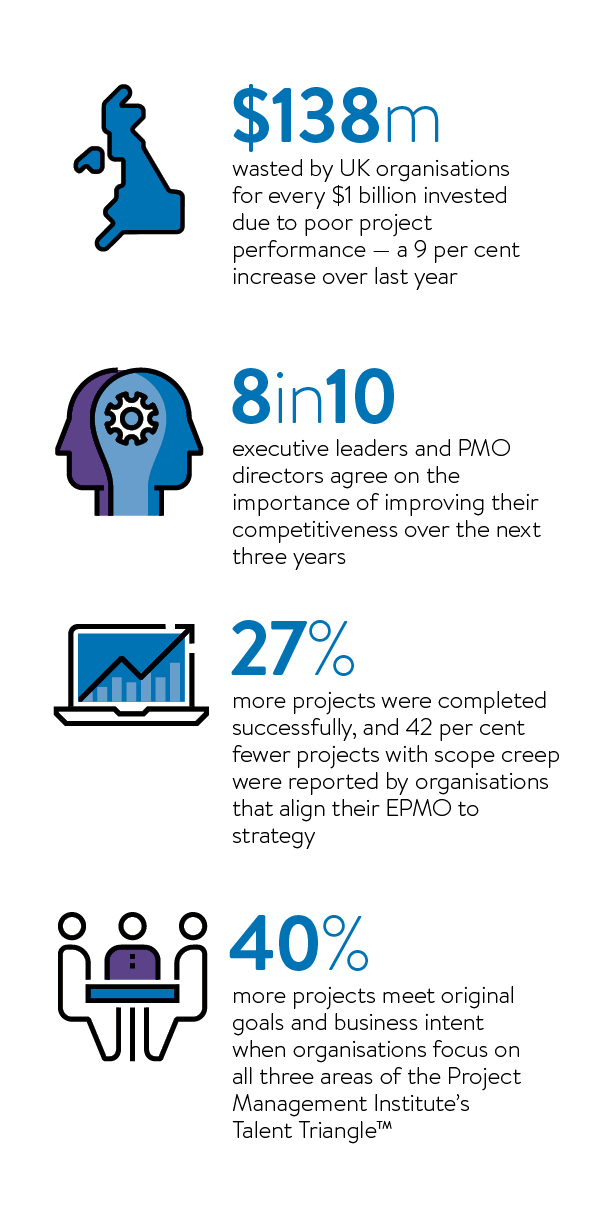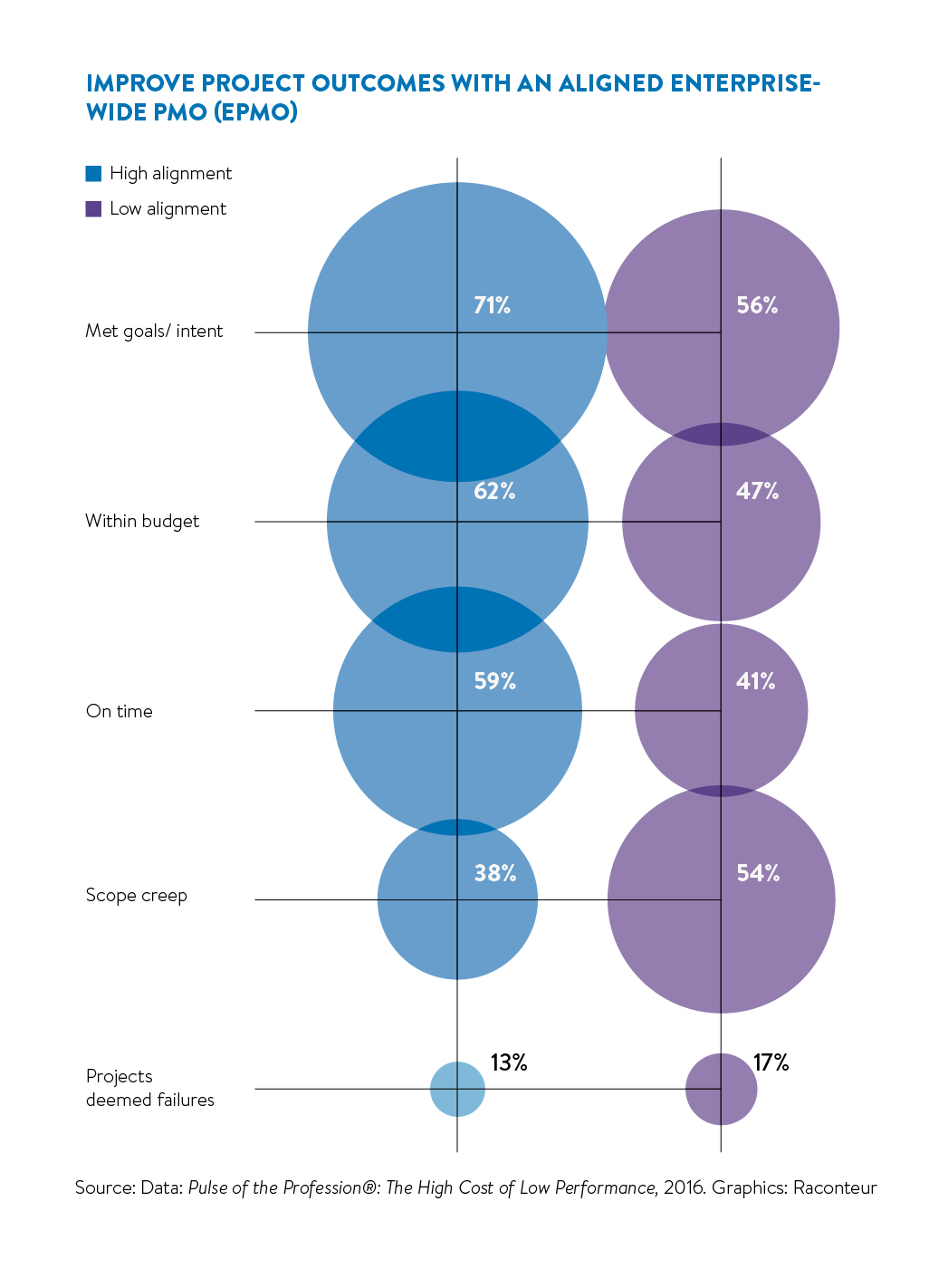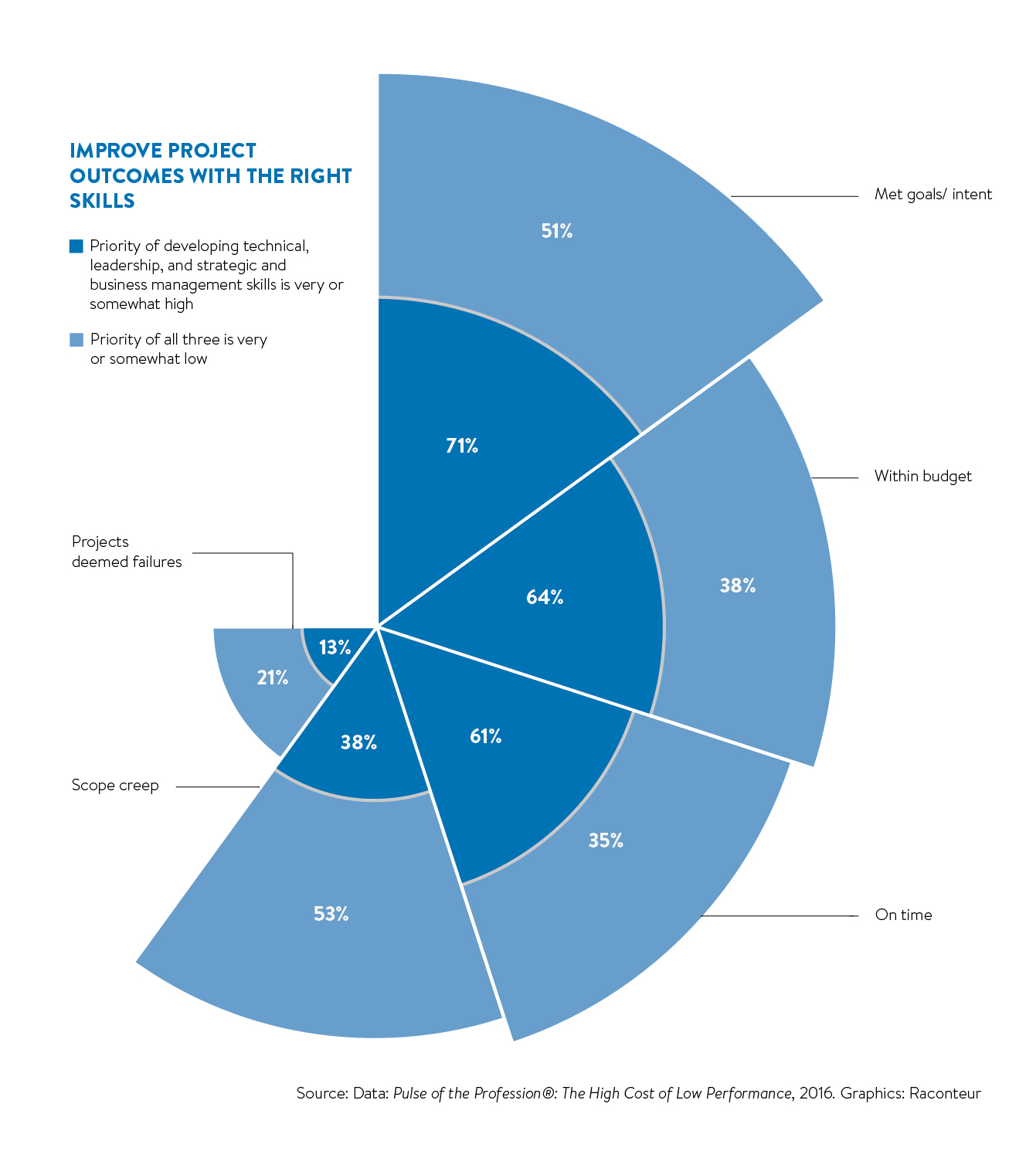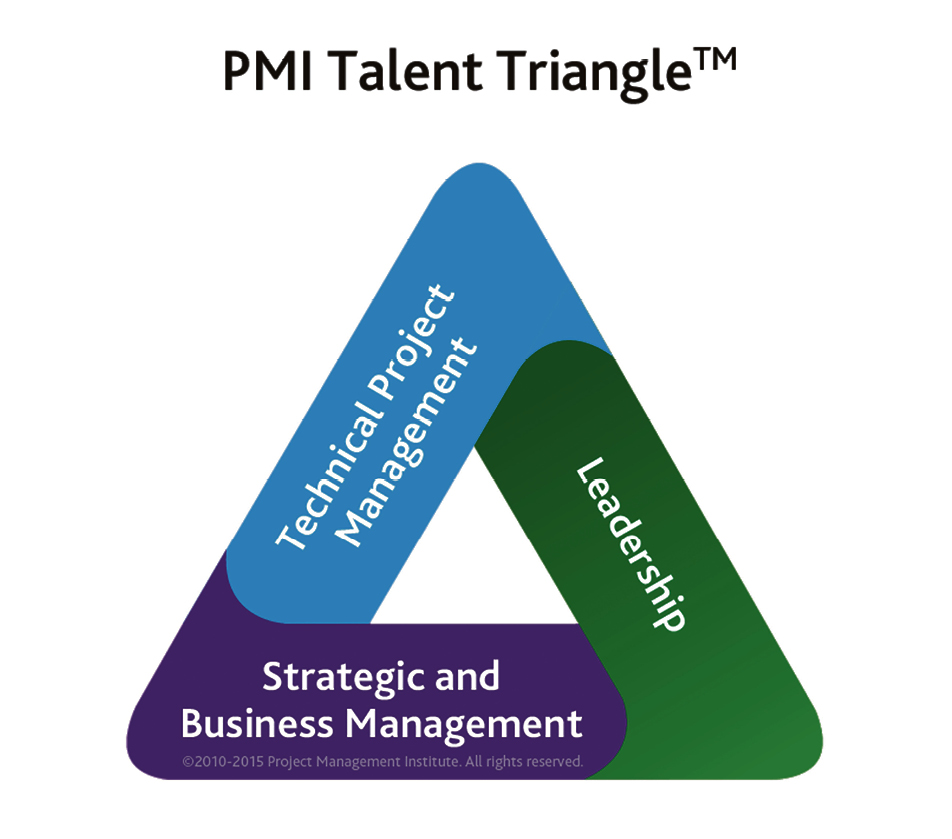Performance – it’s what counts when a critical project is in the pipeline. Your organisation relies on project and executive teams to drive the strategies that convert these projects into measurable business successes.
It’s seldom a straightforward task to align projects with organisational strategy and many businesses struggle as a result. Project Management Institute (PMI) reports in its 2016 Pulse of the Profession®: The High Cost of Low Performance that organisations in the UK continue wasting $138 million for every $1 billion invested in projects and programmes due to poor performance.
The PMO can provide a vital link between strategy and implementation. Without it, organisations face a higher risk of wasted work and redundancy of resources, which affect projects and, ultimately, business performance
To reduce risk and stay competitive, today’s leaders are placing a premium on the alignment of projects and programmes to long-term strategy. Project management offices (PMOs) give organisations a way to strengthen this connection.

Mark A. Langley President and chief executive PMI
“The PMO can provide a vital link between strategy and implementation,” says Mark A. Langley, president and chief executive of Project Management Institute. “Without it, organisations face a higher risk of wasted work and redundancy of resources, which affect projects and, ultimately, business performance.”
The PMO supports execution of project work by equipping the organisation with methodology, standards and tools to enable project managers to better deliver projects. It increases the capability of the organisation by implementing proven practices and providing a central point of contact for project managers.
It may provide training, mentoring and capability development for people, facilitate knowledge management through knowledge transfer, and perform portfolio management functions to ensure strategy alignment and benefits realisation.
STRATEGIC ALIGNMENT
The need for the alignment of projects and strategy is as urgent as ever. According to the Pulse report, executive leaders and PMO directors agree on the importance of improving their competitiveness over the next three years.
Eight in ten executive leaders and PMO directors agree they will achieve that by formulating strategies appropriate for changing market conditions, prioritising and funding the correct initiatives and/or projects, executing initiatives and/or projects in a way that delivers strategic results, and using lessons learnt from failed projects to inform strategic planning.

An effective PMO addresses this need by:
1. Freeing executives to think strategically – rather than being bogged down in project details, executives can focus on strategic alignment;
2. Increasing strategic flexibility – a PMO creates the capacity to select the projects best suited to each moment;
3. Driving business growth through customer satisfaction – a PMO increases the chance that projects will be delivered on time and on budget, which provides tangible value to customers;
4. Improving decision-making – organisations can better evaluate the benefits and risks of individual projects in the context of the entire portfolio.
As businesses begin to undertake more complex projects and develop programmes to manage them, the role of the PMO has become much more visible, providing organisations with project support and guidance.
Furthermore, with responsibility to align projects and programmes to corporate strategy, the PMO establishes and oversees appropriate governance of projects to ensure strategy alignment and benefits realisation. Organisations that align their PMO to strategy report 27 per cent more projects completed successfully and 42 per cent fewer projects with scope creep.
BUILDING YOUR PMO
Where to start? The first priority is to get executive buy-in and make the PMO a partner in strategy. An executive sponsor is key; this is an individual in your organisation whose seniority allows him or her to influence stakeholders, remove obstacles and allocate project resources as needed. The sponsor’s access to other members of the executive leadership team, including the chief executive, helps ensure alignment between the PMO and the overall strategy.
Next, it’s essential to find the right people. If possible, hire internally and recruit from multiple departments, such as sales, marketing operations and IT, to broaden the team skill set. When implementing new processes, look for internal best practices and allow for some local flexibility.
The PMO’s role should be more consultative than administrative or regulatory, adapting practices from the Guide to the Project Management Body of Knowledge (PMBOK® Guide) to individual initiatives within an organisation’s process and culture. The PMO also serves as the central resource for organisational knowledge transfer. By identifying and capitalising on the major contributors to project success and avoiding the leading causes of project failure, project success should be a predictable and repeatable event, instead of a hit-and-miss occurrence.

LONG-TERM SUCCESS
The most effective organisations not only recognise the need for project, programme and portfolio management in everything they do, but also give the PMO its proper credence – management authority, support and tools – within the operational structure of the business. It is vital top executives understand the PMO and the best way to deploy and support it. To create a culture that embraces project management and to increase the business value they bring to the organisation, PMOs need to have clear direction, governance and support.
Staying true to the goals of a project or programme has always been a key element of success, but any number of business and market trends can knock projects – and organisations – off course. An effective PMO helps overcome these inevitable bumps in the road and set a clear course for success.
For more information please visit www.PMI.org.uk
CASE STUDY: PMI 2015 PMO OF THE YEAR AWARD

John McIntyre, head of PMO Ticketmaster International
Ticketmaster International, a finalist for the 2015 PMO of the Year award, has first-hand knowledge of how to strengthen strategic value through a PMO.
When the company merged with Live Nation in 2010, they were tasked with “joining up the ends” between departments, processes and strategy. This entailed controlling the delivery of projects and collecting information to inform good business decisions.
With a budget of more than $2 million, the PMO needed a better way to prioritise its mission-critical initiatives. Product roadmaps and requests were often left hanging in limbo, so the PMO asked each project team to build a business case using a template it provided. This allowed teams to show where they needed more resources, which led to accelerated delivery.
The PMO also brought in an analyst to help teams clearly outline the anticipated business benefits of their projects. Armed with this information, the PMO provided project managers with the tools to address risks and manage change by accessing information about dependencies in real time.
“A strategic PMO must be able to shape the portfolio and the projects that will make a real difference to the business,” says John McIntyre, head of PMO at Ticketmaster International. “Our PMO is testament to PMI’s research findings that the alignment of strategy and portfolio management, along with benefits identification, is key to success. We have used this valuable insight to improve strategic planning, master dependencies, shorten cycle times and increase the strategic value of each project’s output.”
HIGH-PERFORMING PMOs NEED TOP TALENT
There is a challenge to embracing project management that may seem surprising in a labour market still recovering from a sustained recession – the demand for qualified project managers outstrips supply.
This creates a highly competitive job market, so organisations need to be prepared for a real commitment to attracting and retaining the right talent. As part of this, establishing a formal career path for project managers within the organisation is vital to retention.
Organisations that prioritise having the right talent for executing strategic initiatives have a critical capability which gives them a competitive advantage. One way organisations reduce the risk of investing in uncertain skillsets is by including certifications in their project management talent requirements.

Project management certifications, such as the Project Management Professional (PMP®), ensure the hiring organisation that resources are easily transferable across industry sectors, business units and geographical regions. They bring to each role the same set of proven skills and a shared vocabulary with other project managers and those who work with project managers.
While approaches to talent management for project professionals vary across organisations, the skills required by today’s project managers are clear. Well-rounded project managers encompass the multiple skills that make up the Project Management Institute’s Talent Triangle™, with the requisite technical project management skills, strategic and business management skills, and leadership skills to make projects work from the ground up.
In addition to proven technical acumen, they have the business experience and real-world perspective necessary to align projects with an organisation’s long-term goals. More importantly, they’re able to maintain collaborative relationships with the leaders who are driving that strategy.

Leadership skills make the third side of the Talent Triangle and leadership is the catalyst that takes a project from the boardroom table to the showroom floor. Successful project managers must wear many hats and understand multiple business “dialects” to communicate effectively with stakeholders from all areas of the org chart.
When organisations focus on all three areas, 40 per cent more projects meet original goals and business intent. Additional improvements are realised in managing budget, time, scope creep and projects deemed failures.
A variety of factors affect the complex equation of project management talent, other talent management, and executing strategy through projects and programmes. And these factors – external or internal, universal or unique – require attention and action from all stakeholders.
As organisations continue to make complex, higher-stakes initiatives their top priority and place a greater premium on performance, the need for ongoing development of project talent will become more apparent and more acute.

STRATEGIC ALIGNMENT

